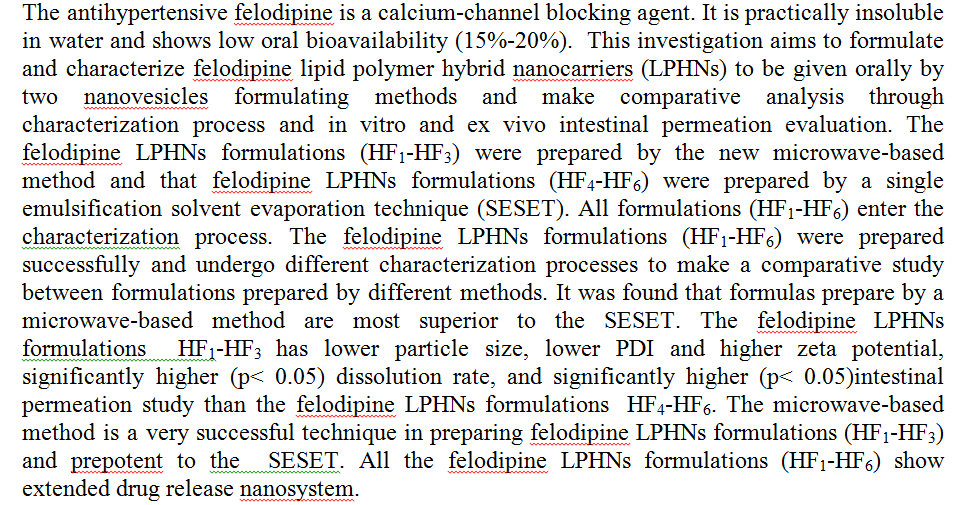The Cu(II) was found using a quick and uncomplicated procedure that involved reacting it with a freshly synthesized ligand to create an orange complex that had an absorbance peak of 481.5 nm in an acidic solution. The best conditions for the formation of the complex were studied from the concentration of the ligand, medium, the eff ect of the addition sequence, the eff ect of temperature, and the time of complex formation. The results obtained are scatter plot extending from 0.1–9 ppm and a linear range from 0.1–7 ppm. Relative standard deviation (RSD%) for n = 8 is less than 0.5, recovery % (R%) within acceptable values, correlation coeffi cient (r) equal 0.9986, coeffi cient of determination (r2) equal to 0.9973, and percentage capita
... Show More (5)
(5)
 (1)
(1)
The present study aimed at identifying the effectiveness of Macaton method in improving some sensory and cognitive skills in autistic children. In order to achieve the aims of the study, the researcher used the experimental method. The present study sample was (10) children whose ages ranged between (7-10) years and were diagnosed medically with autism disorder. The researcher randomly selected the sample and divided it into two groups: the first group consisted of (5) children representing the experimental group, and (5) children representing the control group after extracting the equivalence between the two groups in terms of age, intelligence, economic and social level and the degree of communication. The program was implemented for t
... Show MoreThe aim of this paper is to propose a reliable iterative method for resolving many types of Volterra - Fredholm Integro - Differential Equations of the second kind with initial conditions. The series solutions of the problems under consideration are obtained by means of the iterative method. Four various problems are resolved with high accuracy to make evident the enforcement of the iterative method on such type of integro differential equations. Results were compared with the exact solution which exhibits that this technique was compatible with the right solutions, simple, effective and easy for solving such problems. To evaluate the results in an iterative process the MATLAB is used as a math program for the calculations.
In this paper, a method based on modified adomian decomposition method for solving Seventh order integro-differential equations (MADM). The distinctive feature of the method is that it can be used to find the analytic solution without transformation of boundary value problems. To test the efficiency of the method presented two examples are solved by proposed method.
This paper introduces a non-conventional approach with multi-dimensional random sampling to solve a cocaine abuse model with statistical probability. The mean Latin hypercube finite difference (MLHFD) method is proposed for the first time via hybrid integration of the classical numerical finite difference (FD) formula with Latin hypercube sampling (LHS) technique to create a random distribution for the model parameters which are dependent on time [Formula: see text]. The LHS technique gives advantage to MLHFD method to produce fast variation of the parameters’ values via number of multidimensional simulations (100, 1000 and 5000). The generated Latin hypercube sample which is random or non-deterministic in nature is further integ
... Show More (8)
(8)
 (2)
(2)
Due to their attractive properties, silver nanowires (Ag-NWs) are newly used as nanoelectrodes in continuous wave (CW) THz photomixer. However, since these nanowires have small contact area, the nanowires fill factor in the photomixer active region is low, which leads to reduce the nanowires conductivity. In this work, we proposed to add graphene nanoantenna array as nanoelectrodes to the silver nanowires-based photomixer to improve the conductivity. In addition, the graphene nanoantenna array and the silver nanowires form new hybrid nanoelectrodes for the CW-THz photomixer leading to improve the device conversion efficiency by the plasmonic effect. Two types of graphene nanoantenna array are proposed in two separate photomixer conf
... Show More (2)
(2)
 (1)
(1)
In this work the fabrication and characterization of poly(3-hexylthiophene) P3HT-metallic nanoparticles (Ag, Al). Pulsed Laser Ablation (PLA) technique was used to synthesis the nanoparticles in liquid. The Fourier Transformer Infrared (FTIR) for all samples indicate the chemical interaction between the polymer and the nanoparticles. Scanning Electron Microscopic (SEM) analysis showed the particle size for P3HT-AgNps samples between 44.50 nanometers as well the spherical structure. While for P3HT-AlNps samples was flakes shape. Energy Dispersive X-ray (EDX) spectra show the existing of amount of metallic nanoparticles.
 (5)
(5)
 (4)
(4)
Carbamazepine is an anticonvulsant agent which acts on the central nervous system and used for the treatment of epilepsy. Carbamazepine was formulated as an oral extended release tablets using ethyl cellulose as retardant substance. Different types of tablets additives such as cellulose materials (sodium carboxymethyl cellulose and microcrystalline cellulose ), lactose, calcium phosphate and solubilizing agents ( sodium lauryl sulphate and polyethylene glycol 6000) were utilized to study their effect on the release profile of drug from ethyl cellulose matrices. It was found that sodium carboxymethyl cellulose increased the carbamazepine release and the same effect was obtained when the same amount of microcrystalline cellulose used
... Show MoreGraphite nanoparticles were successfully synthesized using mixture of H2O2/NH4OH with three steps of oxidation. The process of oxidations were analysis by XRD and optics microscopic images which shows clear change in particle size of graphite after every steps of oxidation. The method depend on treatments the graphite with H2O2 in two steps than complete the last steps by reacting with H2O2/NH4OH with equal quantities. The process did not reduces the several sheets for graphite but dispersion the aggregates of multi-sheets carbon when removed the Van Der Waals forces through the oxidation process.
 (7)
(7)
 (2)
(2)

